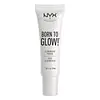What's inside
What's inside
 Key Ingredients
Key Ingredients

No key ingredients
 Benefits
Benefits

 Concerns
Concerns

 Ingredients Side-by-side
Ingredients Side-by-side

Dimethicone
EmollientDisiloxane
Skin ConditioningIsononyl Isononanoate
EmollientDimethicone Crosspolymer
Emulsion StabilisingHdi/Trimethylol Hexyllactone Crosspolymer
Silica
AbrasiveLilium Candidum Leaf Cell Extract
Skin ConditioningBambusa Arundinacea Stem Extract
Skin ConditioningSilica Dimethyl Silylate
EmollientGlycerin
HumectantSodium Hyaluronate
HumectantTocopherol
AntioxidantEthylhexyl Palmitate
EmollientButylene Glycol
HumectantCaprylyl Glycol
EmollientHexylene Glycol
EmulsifyingPhenoxyethanol
PreservativeEthylhexylglycerin
Skin ConditioningDimethicone, Disiloxane, Isononyl Isononanoate, Dimethicone Crosspolymer, Hdi/Trimethylol Hexyllactone Crosspolymer, Silica, Lilium Candidum Leaf Cell Extract, Bambusa Arundinacea Stem Extract, Silica Dimethyl Silylate, Glycerin, Sodium Hyaluronate, Tocopherol, Ethylhexyl Palmitate, Butylene Glycol, Caprylyl Glycol, Hexylene Glycol, Phenoxyethanol, Ethylhexylglycerin
Water
Skin ConditioningCyclopentasiloxane
EmollientGlycerin
HumectantCaprylyl Methicone
Skin ConditioningIsododecane
EmollientDimethicone
EmollientCetyl PEG/PPG-10/1 Dimethicone
EmulsifyingVinyl Dimethicone/Methicone Silsesquioxane Crosspolymer
Propylene Glycol
HumectantPEG-10 Dimethicone
Skin ConditioningPhenyl Trimethicone
Skin ConditioningSilica Dimethyl Silylate
EmollientMagnesium Sulfate
Aluminum Starch Octenylsuccinate
AbsorbentDisteardimonium Hectorite
StabilisingTrimethylsiloxysilicate
EmollientBis-Isobutyl PEG/PPG-10/7/Dimethicone Copolymer
EmulsifyingDimethiconol
EmollientPropylene Carbonate
SolventEthylhexylglycerin
Skin ConditioningPhenoxyethanol
PreservativeCI 77163
Cosmetic ColorantWater, Cyclopentasiloxane, Glycerin, Caprylyl Methicone, Isododecane, Dimethicone, Cetyl PEG/PPG-10/1 Dimethicone, Vinyl Dimethicone/Methicone Silsesquioxane Crosspolymer, Propylene Glycol, PEG-10 Dimethicone, Phenyl Trimethicone, Silica Dimethyl Silylate, Magnesium Sulfate, Aluminum Starch Octenylsuccinate, Disteardimonium Hectorite, Trimethylsiloxysilicate, Bis-Isobutyl PEG/PPG-10/7/Dimethicone Copolymer, Dimethiconol, Propylene Carbonate, Ethylhexylglycerin, Phenoxyethanol, CI 77163
Ingredients Explained
These ingredients are found in both products.
Ingredients higher up in an ingredient list are typically present in a larger amount.
Dimethicone is a type of synthetic silicone created from natural materials such as quartz.
What it does:
Dimethicone comes in different viscosities:
Depending on the viscosity, dimethicone has different properties.
Ingredients lists don't always show which type is used, so we recommend reaching out to the brand if you have questions about the viscosity.
This ingredient is unlikely to cause irritation because it does not get absorbed into skin. However, people with silicone allergies should be careful about using this ingredient.
Note: Dimethicone may contribute to pilling. This is because it is not oil or water soluble, so pilling may occur when layered with products. When mixed with heavy oils in a formula, the outcome is also quite greasy.
Learn more about DimethiconeEthylhexylglycerin (we can't pronounce this either) is commonly used as a preservative and skin softener. It is derived from glyceryl.
You might see Ethylhexylglycerin often paired with other preservatives such as phenoxyethanol. Ethylhexylglycerin has been found to increase the effectiveness of these other preservatives.
Glycerin is already naturally found in your skin. It helps moisturize and protect your skin.
A study from 2016 found glycerin to be more effective as a humectant than AHAs and hyaluronic acid.
As a humectant, it helps the skin stay hydrated by pulling moisture to your skin. The low molecular weight of glycerin allows it to pull moisture into the deeper layers of your skin.
Hydrated skin improves your skin barrier; Your skin barrier helps protect against irritants and bacteria.
Glycerin has also been found to have antimicrobial and antiviral properties. Due to these properties, glycerin is often used in wound and burn treatments.
In cosmetics, glycerin is usually derived from plants such as soybean or palm. However, it can also be sourced from animals, such as tallow or animal fat.
This ingredient is organic, colorless, odorless, and non-toxic.
Glycerin is the name for this ingredient in American English. British English uses Glycerol/Glycerine.
Learn more about GlycerinPhenoxyethanol is a preservative that has germicide, antimicrobial, and aromatic properties. Studies show that phenoxyethanol can prevent microbial growth. By itself, it has a scent that is similar to that of a rose.
It's often used in formulations along with Caprylyl Glycol to preserve the shelf life of products.
This silica is mainly used to thicken oils and suspend particles in oils. It is not water soluble.
According to the manufacturer, it:
The manufacturer also claims this ingredient to be useful in makeup.
In lipstick formulations, this ingredient improves color payoff, reduces pigment settling, and reduces oil bleeding. This ingredient also improves the grip of powder products such as dry shampoos.
Learn more about Silica Dimethyl Silylate